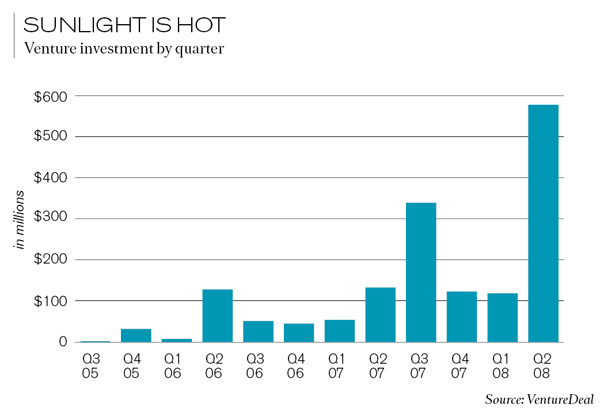Solar Boom
As oil prices have climbed, so has venture investment in alternative energy. According to VentureDeal, a venture-tracking service in Menlo Park, CA, solar-power startups in particular have seen a three-year surge, from a low of no venture investment in the third quarter of 2005 to a high of more than half a billion dollars in the second quarter of this year.

The most popular approach to solar power remains photovoltaic panels made from crystalline silicon. But recent years have seen the commercialization of two rival technologies: thin-film solar cells, in which layers of light-absorbing materials are deposited on glass or even flexible plastic, and solar concentrators, which conserve silicon by using mirrors or optics to focus the sun’s energy onto a smaller area. With VentureDeal’s help, Technology Review has identified solar startups with innovative variations on all three approaches.
CaliSolar
Most solar cells are made from very pure–and thus expensive–silicon. But CaliSolar can make do with silicon that has a thousand times the impurities and can cost a sixth as much. That could mean real savings, since silicon can represent a quarter to a third of the cost of making solar cells. Usually, impurities lower cells’ efficiency by reabsorbing freed electrons. But CaliSolar’s manufacturing process herds impurities together, so electrons are less likely to hit them. The company’s cells convert 15 percent of solar energy into electricity, putting them in the ballpark of conventional cells.
Product: Solar cells made from “dirty” silicon
CEO: Roy Johnson
Location: Sunnyvale, CA
Funding: $13.4 million
Funders: Advanced Technology Ventures, GlobeSpan Capital Partners
URL: calisolar.com
Wakonda Technologies
Thin-film solar cells are inefficient but cheap. Where there’s room to put up a lot of them, they’re cost effective, but to compete elsewhere, they’ll have to get more efficient. Wakonda has found a way to coat a metal foil with some of the most efficient photovoltaic materials known, such as gallium arsenide. The company says that its thin-film cells will be even more efficient than silicon panels. Gallium arsenide is expensive, but Wakonda claims that its films will cost as little as its competitors’.
Product: Thin-film solar cells from superefficient semiconductors
CEO: Les Fritzemeier
Location: Fairport, NY
Funding: $9.5 million
Funders: Advanced Technology Ventures, General Catalyst Partners, Polaris Venture Partners, Applied Ventures
URL: wakondatech.com
Prism Solar Technologies
Prism has engineered a new type of solar concentrator by inscribing holograms in a transparent medium sealed between pieces of glass. Much of the light that strikes a conventional solar cell generates waste heat rather than electricity, but Prism’s holograms can divert unproductive wavelengths of light away from the cell. As a consequence, it can concentrate the productive wavelengths more intensely without fear of overheating. The company claims that it can concentrate light two to three times as much as its competitors can.
Product: Holographic solar concentrators
CEO: Rick Lewandowski
Location: Lake Katrine, NY
Funding: $8.5 million
Funders: Counter Point Ventures, I2BF Venture Capital, Phoenix-Fire II, Walt Robb
URL: prismsolar.com
Keep Reading
Most Popular
Large language models can do jaw-dropping things. But nobody knows exactly why.
And that's a problem. Figuring it out is one of the biggest scientific puzzles of our time and a crucial step towards controlling more powerful future models.
The problem with plug-in hybrids? Their drivers.
Plug-in hybrids are often sold as a transition to EVs, but new data from Europe shows we’re still underestimating the emissions they produce.
How scientists traced a mysterious covid case back to six toilets
When wastewater surveillance turns into a hunt for a single infected individual, the ethics get tricky.
Google DeepMind’s new generative model makes Super Mario–like games from scratch
Genie learns how to control games by watching hours and hours of video. It could help train next-gen robots too.
Stay connected
Get the latest updates from
MIT Technology Review
Discover special offers, top stories, upcoming events, and more.